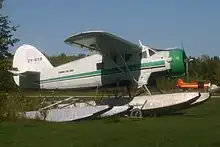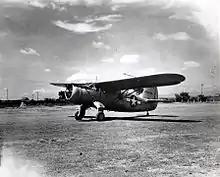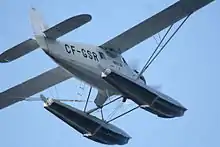| Norseman | |
|---|---|
_(42264321861).jpg.webp) | |
| A restored Norseman VI from the Norwegian Spitfire Foundation | |
| Role | General aviation aircraft |
| Manufacturer | Noorduyn Aircraft Ltd |
| Designer | Robert B. C. Noorduyn |
| First flight | November 14, 1935 |
| Status | 42 registered in Canada, 9 in the United States, unknown worldwide |
| Primary user | Bush plane operators worldwide |
| Produced | 1935–1959 |
| Number built | 904, including prototypes |
The Noorduyn Norseman, also known as the C-64 Norseman, is a Canadian single-engine bush plane designed to operate from unimproved surfaces. Distinctive stubby landing gear protrusions from the lower fuselage make it easily recognizable.
Introduced in 1935, the Norseman remained in production for almost 25 years with over 900 produced. A number of examples remain in commercial and private use to this day. Norseman aircraft are known to have been registered or operated in 68 countries and also have been based and flown in the Arctic and Antarctic regions.
Design and development

Designed by Robert B. C. Noorduyn, the Noorduyn Norseman was produced from 1935 to 1959, originally by Noorduyn Aircraft Ltd. and later by the Canadian Car and Foundry company.
With the experience of working on many ground-breaking designs at Fokker, Bellanca and Pitcairn-Cierva, Noorduyn decided to create his own design in 1934, the Noorduyn Norseman. Along with his colleague, Walter Clayton, Noorduyn created his original company, Noorduyn Aircraft Limited, in early 1933 at Montreal while a successor company was established in 1935, bearing the name Noorduyn Aviation.
Noorduyn's vision of an ideal bush plane began with a high-wing monoplane airframe to facilitate loading and unloading passengers and cargo at seaplane docks and airports; next, a Canadian operator utilizing existing talents, equipment and facilities should be able to make money using it; last, it should be all-around superior to those already in use there.
From the outset, Noorduyn designed his transport to have interchangeable wheel, ski or twin-float landing gear. Unlike most aircraft designs, the Norseman was first fitted with floats, then skis and, finally, fixed landing gear.
The final design looked much like Noorduyn's earlier Fokker designs, a high-wing braced monoplane with an all-welded steel tubing fuselage. Attached wood stringers carried a fabric skin. Its wing was all fabric covered wood, except for steel tubing flaps and ailerons. The divided landing gear were fitted to fuselage stubs; legs were secured with two bolts each to allow the alternate arrangement of floats or skis. The tail strut could be fitted with a wheel or tail skid.
Operational history

The first Norseman, powered by a Wright R-975-E3 Whirlwind, was flight tested on floats on November 14, 1935, and was sold and delivered to Dominion Skyways Ltd. on January 18, 1936, registered as "CF-AYO" and named “Arcturus." In summer 1941, Warner Brothers leased CF-AYO for the filming of "Captains of the Clouds" starring James Cagney. Principal aerial photography took place near North Bay, Ontario with CF-AYO carrying temporary registration "CF-HGO." CF-AYO was lost in a crash in Algonquin Park in 1952. Its wreckage currently is on display at the Canadian Bushplane Heritage Centre.
Almost immediately, the Norseman proved itself to be a rugged, reliable workhorse with steady sales. The first aircraft, CF-AYO, was designated the Norseman Mk I. The next aircraft, "CF-BAU," having some minor changes required after the certification tests, and a new Pratt & Whitney R-1340 Wasp SC-1 engine up-rated from 420 to 450 hp, was designated Norseman Mk II while the next three aircraft were Norseman Mk IIIs: "CF-AZA" going to MacKenzie Air Service, Edmonton, Alberta, "CF-AZE" to Prospector Airways, Clarkson, Ontario and "CF-AZS" to Starrat Airways, Hudson, Ontario. "CF-BAU" would be modified on June 26, 1937 to become the prototype Norseman Mk IV, powered by a Pratt & Whitney Wasp S3H-1. The Mk IV became the "definitive" model but the production run might have ended at a few hundred examples if not for the advent of the Second World War.
Second World War
Until 1940, the Noorduyn company had sold only 17 aircraft in total, primarily to commercial operators in Canada's north and to the Royal Canadian Mounted Police. With the outbreak of war in Europe, demand for a utility transport led to major military orders. The Royal Canadian Air Force and the United States Army Air Forces became the two largest operators; the RCAF ordered 38 Norseman Mk IVWs for radio and navigational training for the Commonwealth Air Training Plan.

USAAF Colonel Bernt Balchen had been involved in establishing a staging route across Greenland to facilitate the ferrying of aircraft from North America to Europe. He required a bush plane rugged enough to survive in the harsh conditions of the Arctic. After evaluating six Norsemans diverted from a previous RCAF order, late in 1941, he recommended the purchase of the Norseman Mk IV specially modified to USAAF requirements as the YC-64A. After the US entry into the Second World War, the USAAF placed the first of several orders for a production version C-64A Norseman. The principal differences involved fitting two fuselage belly tanks bringing the standard fuel capacity to 201 imp gal (910 L; 241 US gal); an additional cabin fuel tank of 32 Imp. gal (145 L) could also be installed. These changes resulted in an increase of 950 lb (430 kg) in the loaded weight of the standard Mk IV. Deliveries began in mid-1942, with the American military eventually placing orders for 749 Norseman Mk IVs as the C-64A (later UC-64A).
Throughout the Second World War, the USAAF Norseman aircraft were used in North America (primarily Alaska) as well as other in theaters of war, including Europe. Three UC-64As were used by the US Navy under the designation JA-1. Six C-64B floatplanes were used by the US Army Corps of Engineers, as well as by other Allied air forces, which placed orders for 43 Norseman Mk IVs. The RCAF ordered an additional 34 aircraft as Norseman Mk VI. Noorduyn was the sole manufacturer, but when the USAAF considered ordering a larger number of C-64As, license production of 600 by Aeronca Aircraft Corp. (Middletown, Ohio) was contemplated before the contract was cancelled in 1943.
Major Glenn Miller was a passenger on a UC-64A Norseman (s/n 44-70285) flown by F/O John R. S. Morgan which disappeared over the English Channel on December 15, 1944, possibly due to aircraft carburetor icing or being struck by bombs jettisoned from RAF Lancasters after an aborted raid.[1]
It was also in 1944 that a Norseman crashed into King Alfred's Tower, a 50 m (160 ft) tall folly in Somerset, England, killing all five air crew. The tower, part of the celebrated Stourhead estate and landscape, was not repaired until 1986 which included the use of a Wessex helicopter to lower a 300 kg (660 lb) stone onto the top.
Postwar

In postwar production, the Canada Car and Foundry in Fort William, Ontario acquired rights to the Norseman design, producing a version known as the Norseman Mk V, a civilian version of the wartime Mk IV. In order to exploit the market further, the "Can Car" factory designed and built the Norseman Mk VII. This version had a bigger engine, a new all-metal wing and greater cargo capacity but was fated never to go into production. With large Korean War commitments at that time, the company put it into temporary storage where it was destroyed in a hangar fire in September 1951.
In 1953, Noorduyn headed a group of investors who bought back the jigs and equipment from Canada Car and Foundry and started a new company called Noorduyn Norseman Aircraft Ltd. Bob Noorduyn became ill and died at his home in South Burlington, Vermont, on 22 February 1959. The company continued to provide support for operating Norseman aircraft and built three new Mk Vs before selling its assets in 1982 to Norco Associates. Norco provided support services only, as Norseman aircraft manufacture was labor-intensive and very expensive.

The last Noorduyn Norseman to be built was sold and delivered to a commercial customer on January 19, 1959. A total of 903 Norseman aircraft (Mk I – Mk V) were produced and delivered to various commercial and military customers. There are currently 42 Norseman aircraft on the active Canadian aircraft registry and 9 active in the United States. The number in use worldwide is not known.
In recognition of the Norseman's role in serving the remote villages of northern Canada, the town of Red Lake, Ontario, a jumping-off point for remote communities in Northwestern Ontario, promotes itself as The Norseman Capital of the World. Each summer in July, the "Norseman Floatplane Festival" brings Norseman aircraft to Red Lake as the centrepiece of a community based weekend festival ranging from stage entertainment, children's games and rides, contests, cultural and historical displays and street vendors with craft and specialty booths.
The Canadian Second World War "ace-of-aces" George Beurling died in a Norseman while landing at Urbe Airport in Rome, Italy, in May 1948. Beurling had been ferrying the aircraft to the nascent Israeli Air Force. The remains of another Israeli Air Force Norseman adorn the IAF's memorial to its fallen on Har Hatayasim (Pilots' Mountain) near Jerusalem. The plane had crashed during Operation Maccabi of the 1948 Arab-Israeli War.[2][3]
Operators
Major civil operators


- Austin Airways (retired)
- Bearskin Airlines (retired)
- Buffalo Airways (retired)
- Canadian Airways & Western Canada Airways (retired)
- Canadian Pacific Airlines (retired)
- Central Northern Airways (retired)
- Imperial Oil (retired)
- Lamb Air
- Ontario Central Airlines (retired)
- Ontario Provincial Air Service - 4 (1943 to 1947) eventually sold 1951 to 1952
- Pacific Western Airlines
- Royal Canadian Mounted Police
- Saskatchewan Air Ambulance
- Saskatchewan Government Airways
- Starratt Airways
- Far Eastern Air Transport Inc. (FEATI) (1946-1947)
- Philippine Airlines (transferred from FEATI, from 1947-1955)
Military operators


- Royal Australian Air Force operated 14 aircraft from 1943 to 1946.
- No. 1 Communications Unit RAAF
- No. 3 Communications Unit RAAF
- No. 4 Communications Unit RAAF
- No. 5 Communications Unit RAAF
- No. 7 Communications Unit RAAF
- Brazilian Air Force operated 19 aircraft from 1944 to 1960
- Royal Canadian Air Force operated 79 aircraft from 1940 to 1953
- Royal Canadian Navy operated 21 aircraft from 1943 to 1957
- Air Surveillance Service operated one aircraft in 1948
- Cuban Air Force received one aircraft in 1951
- Czechoslovakian Air Force operated Norseman postwar under designation K-73.
- Egyptian Air Force operated two aircraft from 1948 to 1960
- Honduran Air Force operated two aircraft from 1945 to 1961
- Indonesian Air Force received one aircraft in 1950

- Israeli Air Force operated 17 aircraft from 1948 to 1954
- Royal Netherlands East Indies Army Air Force operated one aircraft from 1948 to 1950
- Royal Norwegian Air Force operated 22 aircraft from 1945 to 1959
- Philippine Air Force operated two aircraft from 1946 to 1952
- Swedish Air Force operated from 1949 three aircraft as air-rescue/ambulance transports. One was lost in a crash in 1954, a second in a fire at F 4 in 1956, and the last was sold in 1959. In 1980, it was purchased by Swedish Air Force Museum and in restored is part of the exhibition since 1989.
- United States Army Air Corps
- United States Army Air Forces
- United States Air Force
- United States Navy purchased three Norsemans in 1945 (under designation JA-1) to support Antarctic expeditions like Operation Highjump.
Specifications (Norseman Mark V)

Data from Jane's all the World's Aircraft 1947.[4]
General characteristics
- Crew: 1
- Capacity: 10
- Length: 32 ft 4 in (9.86 m)
- Wingspan: 51 ft 6 in (15.70 m)
- Height: 10 ft 1 in (3.07 m)
- Wing area: 325 sq ft (30.2 m2)
- Airfoil: NACA 2412
- Empty weight: 4,240 lb (1,923 kg)
- Max takeoff weight: 7,400 lb (3,357 kg) ;7,540 lb (3,420 kg) with floats
- Fuel capacity: 100 imp gal (120 US gal; 450 L) in two wing roots + optional 37.4 imp gal (44.9 US gal; 170 L) or 2x 101.6 imp gal (122.0 US gal; 462 L) auxiliary tanks in the cabin
- Powerplant: 1 × Pratt & Whitney R-1340-AN1 9 cyl.air cooled radial piston engine, 600 hp (450 kW)
- Propellers: 3-bladed Hamilton Standard, 9 ft 0.75 in (2.7623 m) diameter constant-speed propeller
Performance
- Maximum speed: 155 mph (249 km/h, 135 kn) landplane; 138 miles per hour (120 kn; 222 km/h) (skis); 134 miles per hour (116 kn; 216 km/h) (floats)
- Cruise speed: 130 mph (210 km/h, 110 kn) KTAS at 10,000 ft (3,000 m)
- Stall speed: 68 mph (109 km/h, 59 kn)
- Range: 932 mi (1,500 km, 810 nmi) at 10,000 ft (3,000 m)
- Service ceiling: 17,000 ft (5,200 m)
- Rate of climb: 591 ft/min (3.00 m/s) at 100 miles per hour (87 kn; 161 km/h)
- Wing loading: 22.8 lb/sq ft (111 kg/m2)
- Power/mass: 0.08 hp/lb (0.13 kW/kg)
- Maximum - Flaps extended (Vfe): 108 miles per hour (94 kn; 174 km/h)
See also
Aircraft of comparable role, configuration, and era
Related lists
References
Notes
- ↑ "Glenn Miller book clears RAF of accidentally killing band leader". The Guardian. 29 August 2017. Retrieved 29 August 2017.
- ↑ "Walking from Har Tayyasim to Ein Tayyasim". Jewish National Fund. Retrieved 8 April 2017.
- ↑ Man, Nadav (26 June 2008). "With a stick and a backpack: Hikes in 1920s – part 3". Ynetnews. ynet. Retrieved 8 April 2017.
- ↑ Bridgman, Leonard, ed. (1947). Jane's all the World's Aircraft 1947. London: Sampson Low, Marston & Co. p. 96c.
Bibliography
- Grant, Robert S. (Winter 1993). "Finland's Elephant: A Norseman's Life". Air Enthusiast. No. 52. p. 52. ISSN 0143-5450.
- Grant, Robert S. Noorduyn Norseman: Red Lake, Ontario, Canada, Norseman Capital of the World. Red Lake, Ontario: Norseman Floatplane Festival, 2007. (booklet)
- Harding, Stephen (November–December 1999). "Canadian Connection: US Army Aviation's Penchant for Canadian Types". Air Enthusiast (84): 72–74. ISSN 0143-5450.
- Mathisrud, Nils. Norwegian Wings #1: Noorduyn Norseman Mk. IV & Mk. VI. Oslo: FlyGloster Publishing, 2007. ISBN 978-82-92822-00-5.
- Milberry, Larry. Aviation in Canada. Toronto: McGraw-Hill Ryerson, 1979. ISBN 0-07-082778-8.
- Munson, Kenneth. Bombers, Patrol and Transport Aircraft 1939-1945. London: Blandford Press, 1969. ISBN 0-7537-0919-8.
- "Pentagon Over the Islands: The Thirty-Year History of Indonesian Military Aviation". Air Enthusiast Quarterly (2): 154–162. n.d. ISSN 0143-5450.
External links
- Norduyn website (company name altered)
- Archived Noorduyn Norseman website
- Unofficial Noorduyn Norseman website
- Archived historical website, maintained by Julie Boddy, great-granddaughter of Robert B.C. Noorduyn